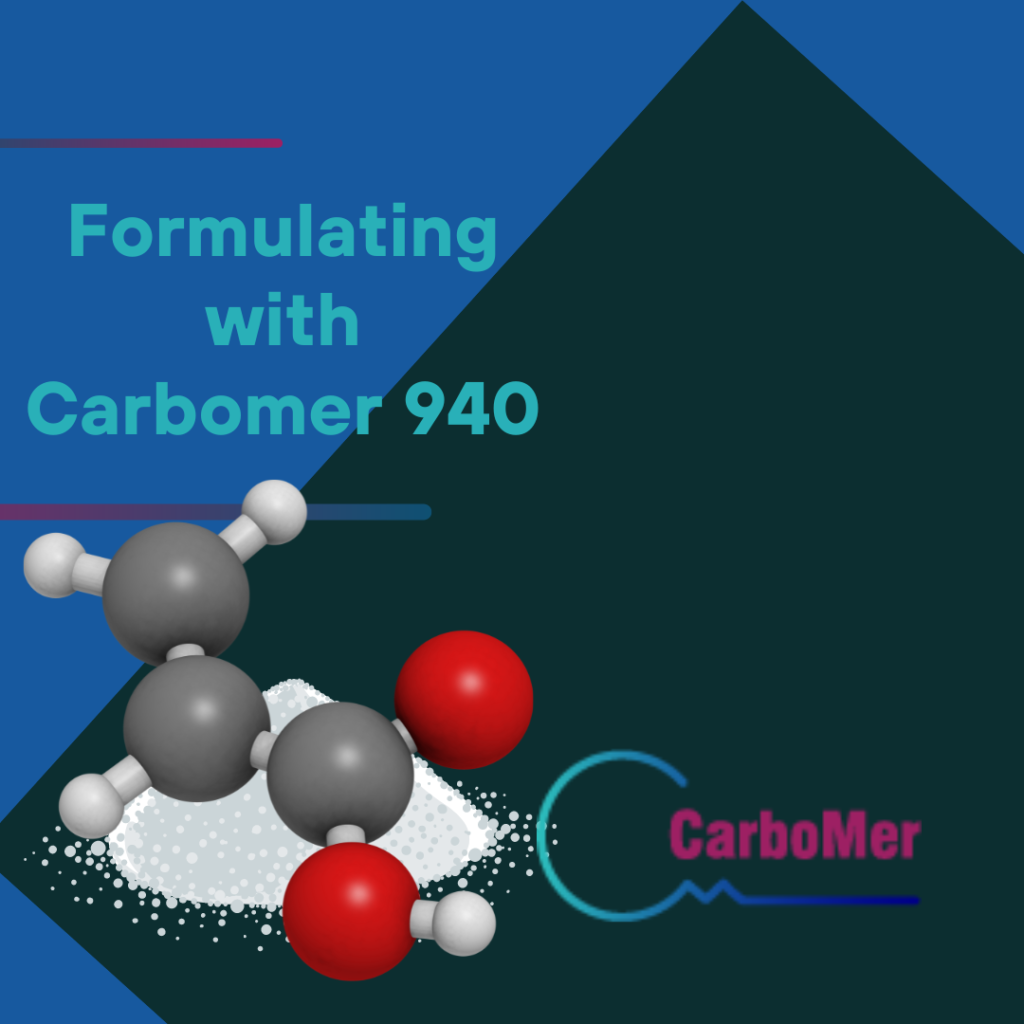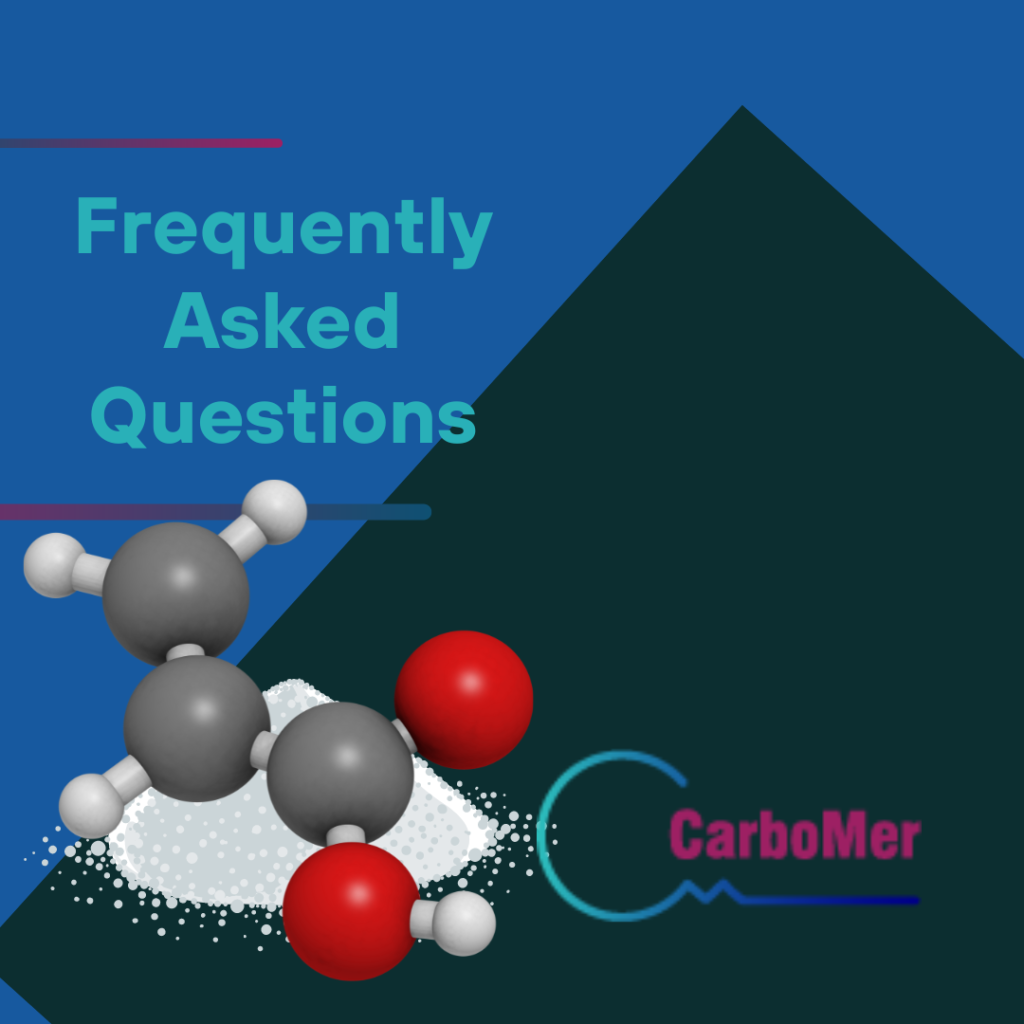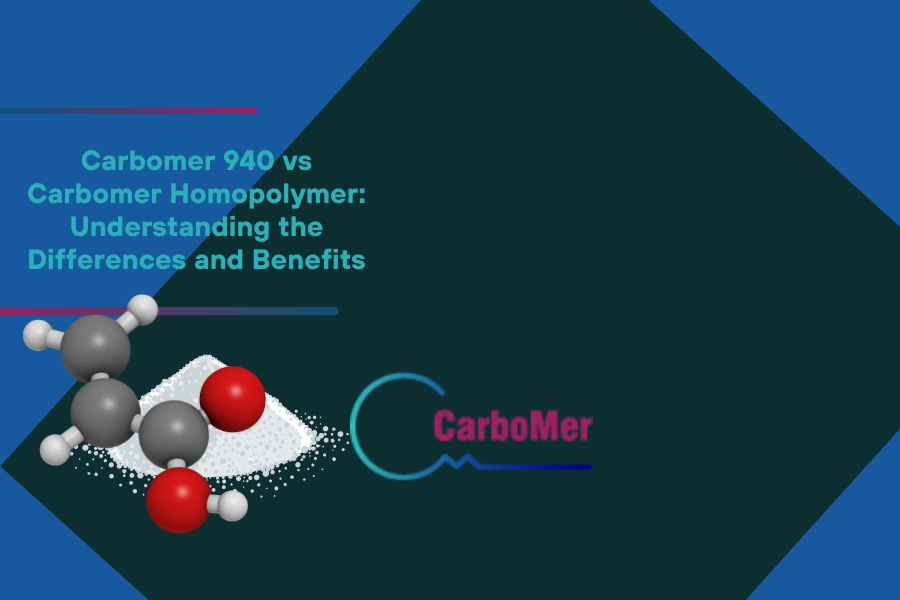Selecting between Carbomer 940 and Carbomer homopolymer can be critical for your product’s performance. In this article, we discuss “Carbomer 940 vs Carbomer Homopolymer” by precisely contrasting their chemical structures and functional capacities, offering practical insights for their optimal use in various applications. Make an informed decision on the best carbomer for your needs as we break down the critical differences that affect everything from viscosity to transparency in formulations.
Key Takeaways
- Carbomer 940, a type of Carbomer homopolymer, is specifically valued for its high viscosity, transparency, and low ion resistance, making it ideal for varied applications in cosmetics and pharmaceuticals.
- The synthesis process of Carbomer polymers, particularly Carbomer 940, involves chemical cross-linking that contributes to their high molecular weight, absorption capacity, and viscosity – crucial for their performance in product formulations.
- Carbomer technology improvements are focusing on environmentally-friendly processes and the exclusion of toxicologically controversial substances, with many Carbomers now used for their stabilizing, emulsifying, and moisture retention properties in skincare and pharmaceuticals.

Distinguishing Carbomer 940 and Carbomer Homopolymer
Carbomer, known in the trade as crosslinked Polyacrylic Acid Polymer, is a synthetic, crosslinked polymer of acrylic acid boasting a high molecular weight. Among the various types of Carbomer, Carbomer 940 stands out as a homopolymer of acrylic acid crosslinked with allyl ethers of Pentaerythritol. This unique composition imbues it with distinctive rheological properties, such as high viscosity, high transparency, and low ion resistance, which make it a preferred choice for a host of applications.
Yet, one must not overlook the variety among Carbomer homopolymers. Other homopolymers like Carbopol 934, 941, and 971 each offer a unique blend of rheological properties, viscosity, transparency, and ion resistance. This diversity determines their specific uses in a wide array of products.

The Science Behind the Polymers
What makes Carbomer polymers special is their synthesis process. Through a chemical cross-linking process involving acrylic acid or acrylate and allyl ether, these polymers are born. Catalysts like Allyl Sucrose or Allyl Pentaerythritol, used in a process known as free radical precipitation polymerization, contribute significantly to the distinctive properties of Carbomer polymers. This polymerization process is essential for their unique characteristics.
The end result? Take Carbomer 940, for example; it’s a product of the polymerization of Acrylic Acid that forms a high-molecular weight, cross-linked polyacrylic acid.
Cross-Linked Polyacrylate Polymer Characteristics
The degree of cross-linking in Carbomer polymers serves as a key determinant of their water absorption capacity. In essence, the higher the degree of cross-linking, the greater the polymer’s capacity to absorb water. This cross-linking results in the formation of microgels that can significantly swell in water upon neutralization, thereby enhancing their water absorption capabilities.
The neutralization of Carbomer polymers triggers a stretching of the molecular chains, due to repulsion between ionized carboxyl groups. This stretching results in an increase in the polymers’ volume, subsequently enhancing their viscosity. But the story doesn’t end there; hydrogen bonding also plays a role in the thickening effect in carbomer polymers, where carbomer molecules bond with hydroxyl groups.
Molecular Weight Matters
Carbomer Polymers tote a very high molecular weight, ranging from 10^8 to 10^9 g/mol, a factor that is crucial for their performance and functionality. This molecular weight, combined with the degree of cross-linking, influences the suspension stability characteristics and fluidity lengths of the Carbomer.
Hence, the molecular weight is an influential parameter impacting the overall performance of Carbomer in various applications.

Formulating with Carbomer 940
In the realm of formulation, Carbomer 940 emerges as a revolutionary element. It provides superior thickening capacity at lower concentrations, creating stable formulations suitable for an array of cosmetics, including moisturizers and cleansers.
This polymer can efficiently thicken surfactant systems, creating stable suspensions that can hold heavy particles without being reliant on viscosity alone.
Ideal pH Range for Optimal Performance
The pH significantly impacts the peak performance of Carbomer 940. Before neutralization, the pH of a Carbomer 940 gel sits at around 3.3, which needs to be increased for the polymer to effectively thicken the product. Post-neutralization, this polymer displays optimal performance at a pH range of 5.5-7, fitting perfectly with the pH levels common in personal care and cosmetic products.
Notably, Carbomer Polymers, such as Carbomer 940, demonstrate heightened viscosity and a gel-like texture when the pH is adjusted to alkaline levels, starting above pH 4 to 6. Acting as a rheological modifier, the stable and effective pH range for Carbomer 940 to maintain performance spans from pH 4 to 10.
Achieving Desired Viscosity
The manipulation of the concentration of Carbomer 940 in a formulation can significantly influence the viscosity of the final product, including achieving a low viscosity. To attain a high yield value, a measurement of viscosity, Carbomer 940 should be applied in the appropriate concentration. This concentration typically lies between 0.25% to 0.5%, and can be adjusted to achieve a desired viscosity in the preparation of emulsions, creams, and gels.

Leveraging Carbomer Homopolymer Advantages
Over the past five decades, Carbomer homopolymers have established a strong market reputation, demonstrating their reliability in personal care formulations. These polymers offer a bounty of advantages, including, but not limited to, emulsification, moisture retention, and protective effects in skincare products.
Compatibility with Various Solvents
Carbomer homopolymers are synthesized in ethyl acetate or a cosolvent mixture of ethyl acetate and cyclohexane. This shift in solvents is driven by safety concerns, replacing the use of the increasingly restricted benzene in pharmaceutical applications.
Carbomer homopolymers synthesized in these safer solvents are recommended for new drug development projects due to compliance with safety standards.
Enhancing Skin Care Products
Carbomer homopolymers prove to be excellent emulsifiers in skincare products, adding moisture retention properties that enrich products such as lotions and creams by improving their texture and consistency. Their protective effects include reducing skin irritation, preventing allergic reactions in cosmetics, and enhancing the skin’s resistance to ultraviolet rays to minimize UV damage.

Technical Considerations in Selection
While selecting Carbomer polymers for particular applications, it is imperative to consider elements like stability and resistance to interference.
For instance, Carbopol 71G NF is a granular Carbomer specifically formulated for direct compression in oral solid dose manufacturing, highlighting its compatibility with a specific pharmaceutical end-use application.
Stability and Resistance to Interference
The stability of Carbomer polymers is an important factor to consider. The viscosity of Carbomer 940 formulations can be compromised by the presence of cations; therefore, stabilizers such as Tetrasodium EDTA are used to maintain the desired viscosity.
Metal ions and strong electrolytes can destabilize carbomer gel formulations, often requiring the addition of stabilizing agents like sodium metabisulfite, EDTA, sodium salt, and sodium hydroxide.
Processing and Manufacturing Ease
Advancements in Carbomer technology have led to polymers with self-wetting capabilities and easier dispersion, thereby streamlining processing.
Carbopol Ultrez polymers, for example, feature self-wetting capabilities that reduce the need for high shear mixing. This makes them easier to disperse compared to traditional Carbomer 940, simplifying processing.

Carbomer in the Pharmaceutical Industry
Carbomer homopolymers exhibit versatility in pharmaceutical applications, functioning as suspending agents, rate-controlling agents, and protease enzyme inhibitors.
Carbomer 940, in particular, fulfills multiple roles in pharmaceutical preparations, acting as a suspending agent, gel base, emulsifier, and binding agent.
Drug Delivery Systems
Carbomer polymers can improve mucoadhesion and bioavailability in drug delivery systems. Carbopol Polymers, for instance, interact with mucosal surfaces and may facilitate paracellular transport, thus enhancing drug bioavailability.
Their swelling behavior can improve mucoadhesion in formulations, which supports controlled and extended drug release.
Topical Medications and Gels
Carbomer is utilized in ophthalmic preparations due to its viscosity enhancing properties, which are crucial in formulating eye drop gels. Carbomer-based hydrogels are effective in wound care as they can absorb exudates and maintain a moist wound environment.
Their mucoadhesive strength allows gels to adhere to wound surfaces, providing a protective barrier and facilitating drug delivery.

Innovations in Carbomer Technology
Recent breakthroughs in Carbomer technology have resulted in the creation of new carbomer copolymer products with specific functions for pharmaceutical and cosmetic applications.
For instance, Carbomer 974P, a newer type of carbomer, is utilized as a major non-aqueous component in BufferGel, contributing to its buffering, microbicidal, and spermicidal capacities.
Toxicologically Preferred Options
New formulations of Carbomers are being actively developed to exclude toxicologically controversial substances, reinforcing safety and ensuring adherence to regulatory standards. Carbomer 940, for instance, has been rigorously assessed for toxicity and found to have a low potential for causing toxicity or irritation in various applications such as dermal, ocular, and oral uses.
Sustainable Manufacturing Processes
Carbomer technology is progressing towards adopting more environmentally-friendly manufacturing process by applying green chemistry principles. The manufacturing processes for Carbopol and Pemulen polymers currently adhere to 10 out of the 12 Green Chemistry Principles, indicating a strong commitment to reducing environmental impact.
Looking ahead, Lubrizol aims to fulfill all 12 Green Chemistry Principles, with future developments centered on the use of renewable feedstock and the design of products that degrade more efficiently.

Summary
To wrap up, Carbomer polymers, particularly Carbomer 940, have revolutionized the cosmetic and pharmaceutical industries with their superior properties and diverse functionalities. From the polymerization process to achieving desired viscosity, and from enhancing skincare products to drug delivery systems, the versatility of these polymers is truly impressive. As we move forward, the focus on safety, sustainability, and innovation continues to drive the development of this remarkable material.

Frequently Asked Questions
What sets Carbomer 940 apart from other Carbomer homopolymers?
Carbomer 940 is distinguished from other Carbomer homopolymers by its short rheological properties, high viscosity, high transparency, low ion resistance, and low shear resistance.
What is the ideal pH range for optimal performance of Carbomer 940?
The ideal pH range for optimal performance of Carbomer 940 is 5.5-7 after neutralization. It is important to maintain this pH range for best results.
How does the concentration of Carbomer 940 influence the viscosity of a product?
The concentration of Carbomer 940, usually between 0.25% to 0.5%, can be adjusted to influence the viscosity of emulsions, creams, and gels in order to achieve the desired consistency.
What are the advantages of Carbomer homopolymers in skincare products?
Carbomer homopolymers act as excellent emulsifiers in skincare products, enhancing moisture retention and improving product texture and consistency. This makes them beneficial for formulating effective skincare products.
How are innovations in Carbomer technology enhancing sustainability?
Innovations in Carbomer technology are enhancing sustainability by embracing green chemistry principles to make manufacturing processes more sustainable, reducing environmental impact, and enhancing human health and safety.

